Abstract
A large body of information exists describing the inability of animals receiving inoculations of antigen either intravenously (i.v.) or via the anterior chamber of the eye (AC) to mount delayed hypersensitivity (DH) responses to the injected antigen. Evidence indicates that the deviant humoral and cellular immunity that follows AC and i.v. inoculations of antigen is mediated, in part, by active suppression. Because of these similarities, it has been argued that immune deviation resulting from the AC inoculation [anterior chamber-associated immune deviation (ACAID)] of antigen represents nothing more than deviant immune responses known to be induced by the i.v. inoculation of antigens. Since circumstantial evidence suggests that AC injections may have unique immune effects, we wished to test the hypothesis that AC exposure to antigen elicits a unique form of systemic immune regulation. We have studied and compared the functional and phenotypic properties of suppressor cell populations induced by AC and i.v. inoculations of a soluble antigen, bovine serum albumin (BSA). Results indicate that AC inoculations of BSA (but not i.v. inoculations) activate antigen-specific. CD8+, I-J+ T lymphocytes which suppress the expression of DH responses, i.e. efferent suppression. We further report that AC and i.v. injection routes both activate antigen-specific afferent suppressor cell populations which impair the inductive phase of the immune response. However, the i.v.-induced afferent suppressor cells are CD8+ I-J+, whereas the AC-induced afferent suppressor cells are CD4+. We conclude that AC and i.v. exposures to soluble antigens are not immunologically equivalent, and that ACAID represents a uniquely regulated systemic immune response to intraocular antigens.
Full text
PDF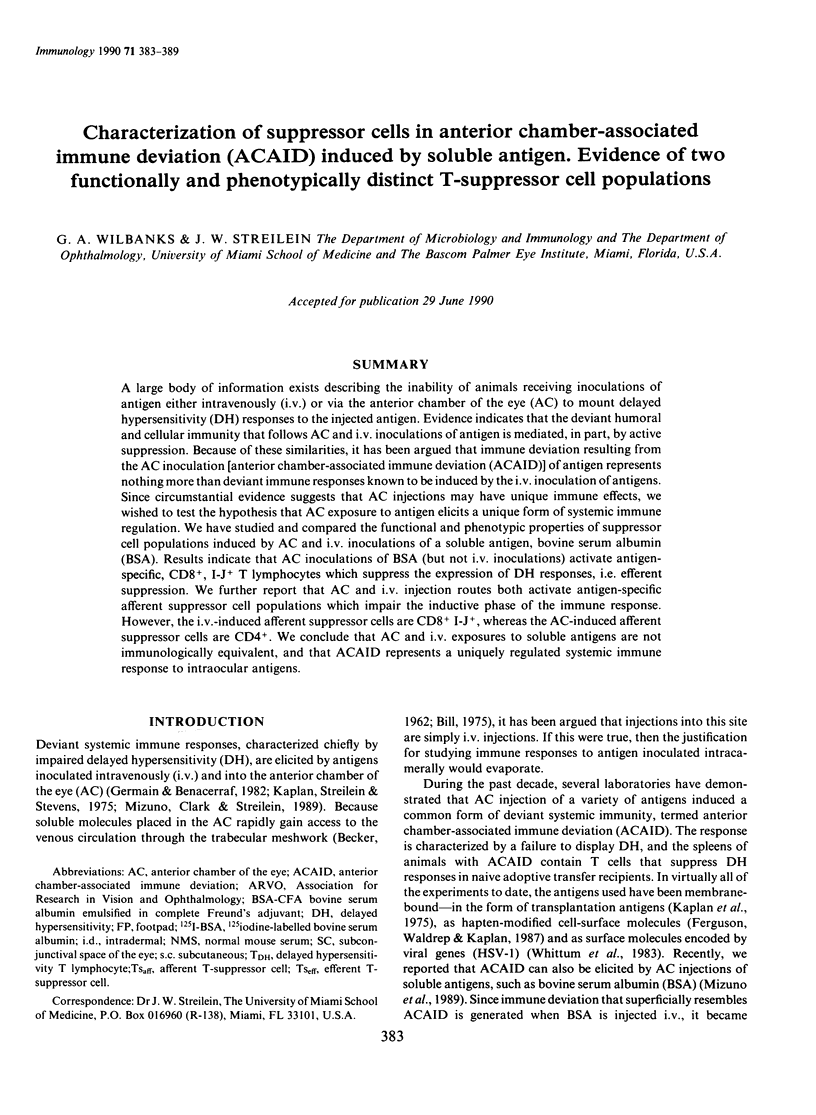
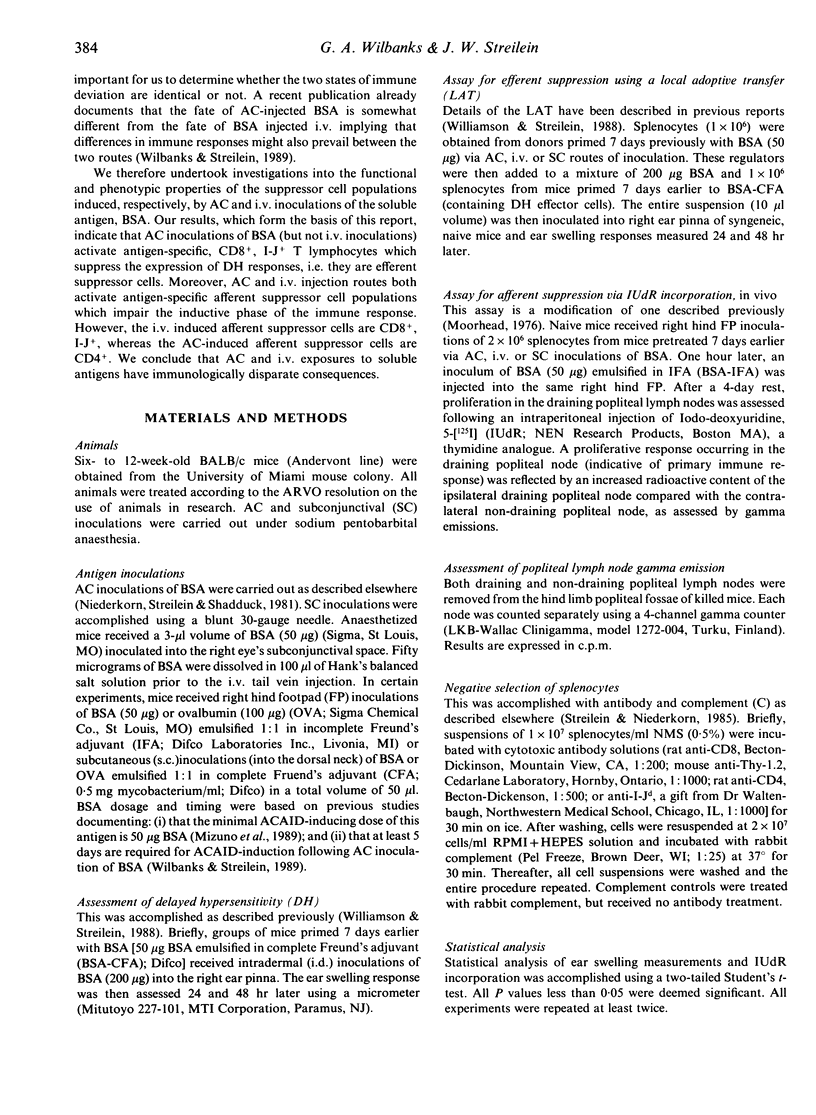
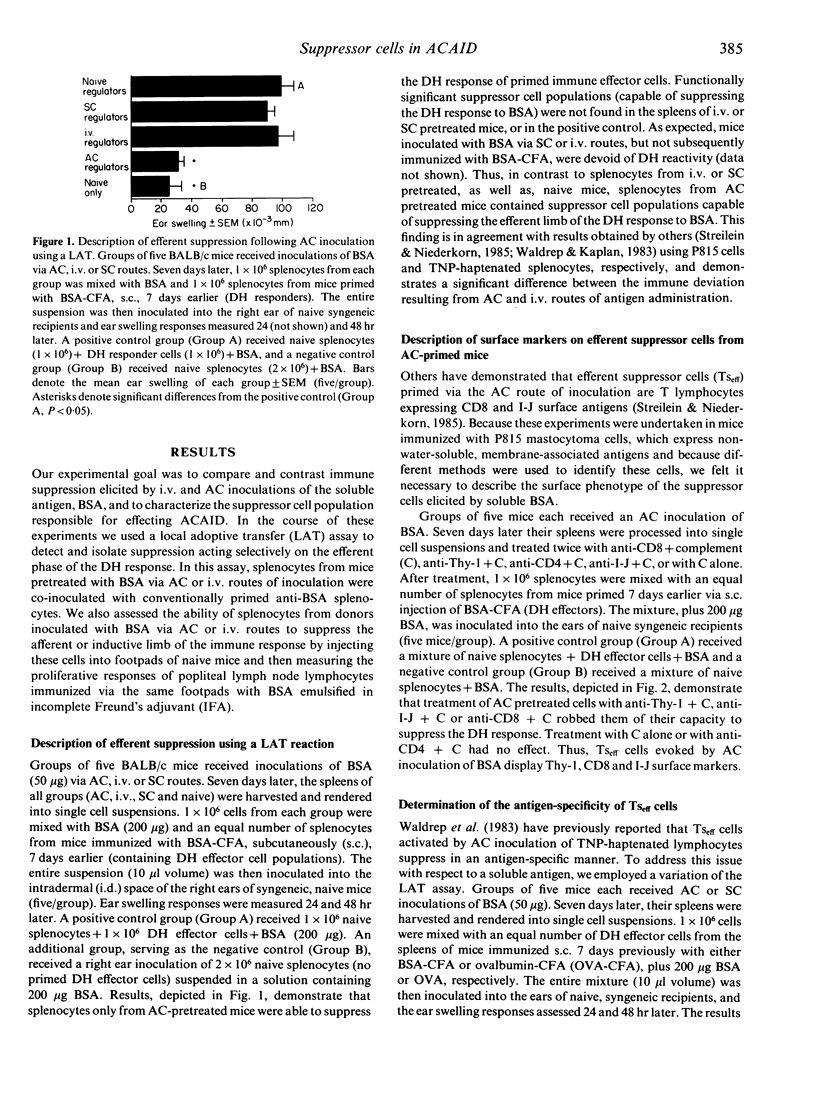
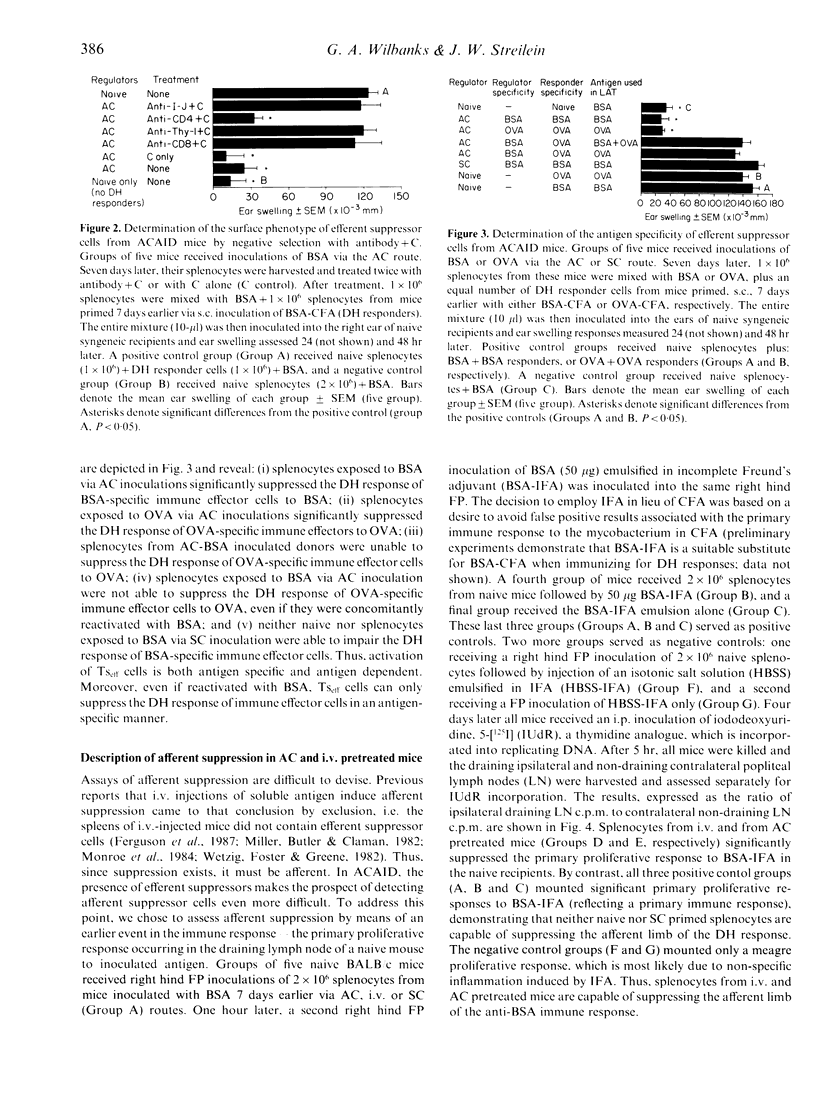
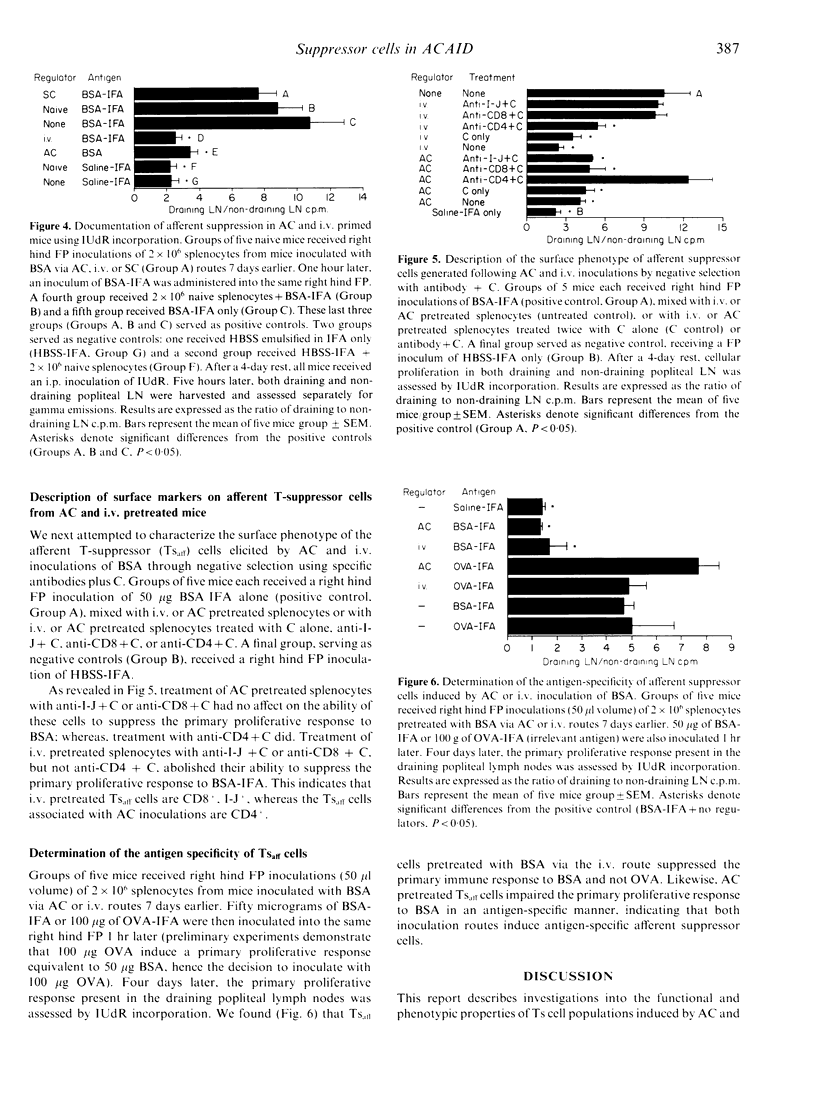
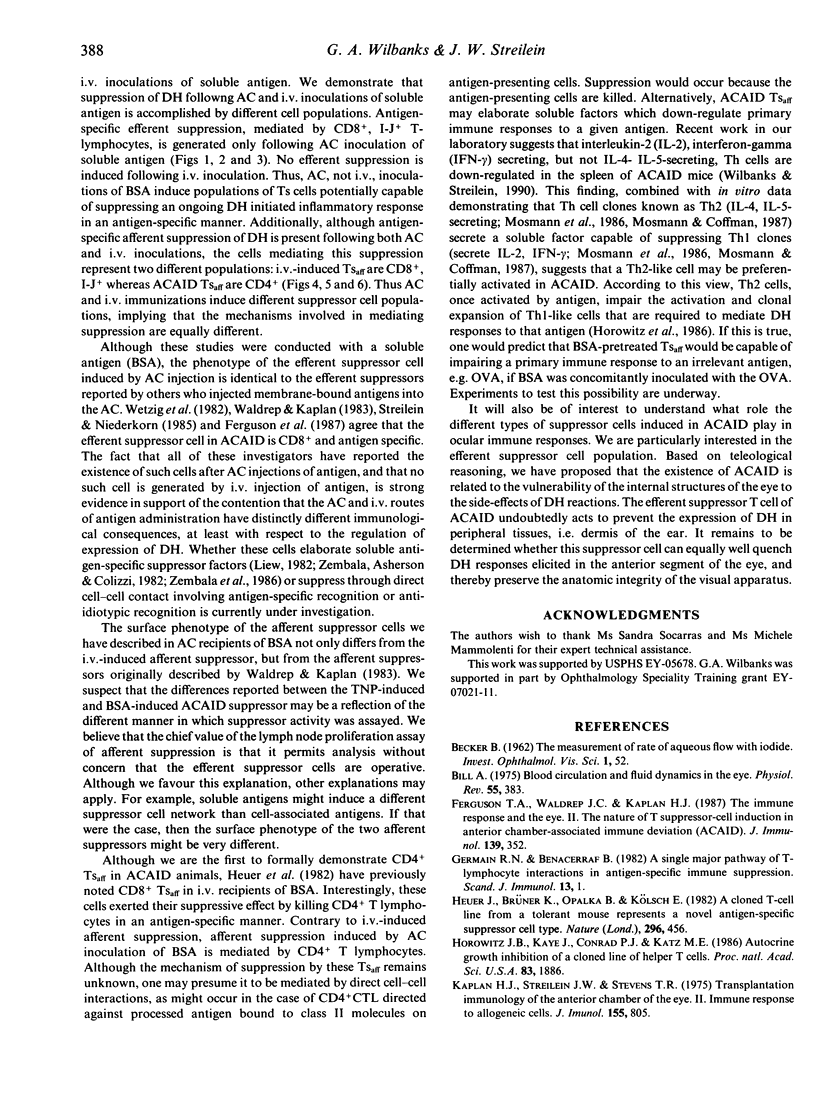
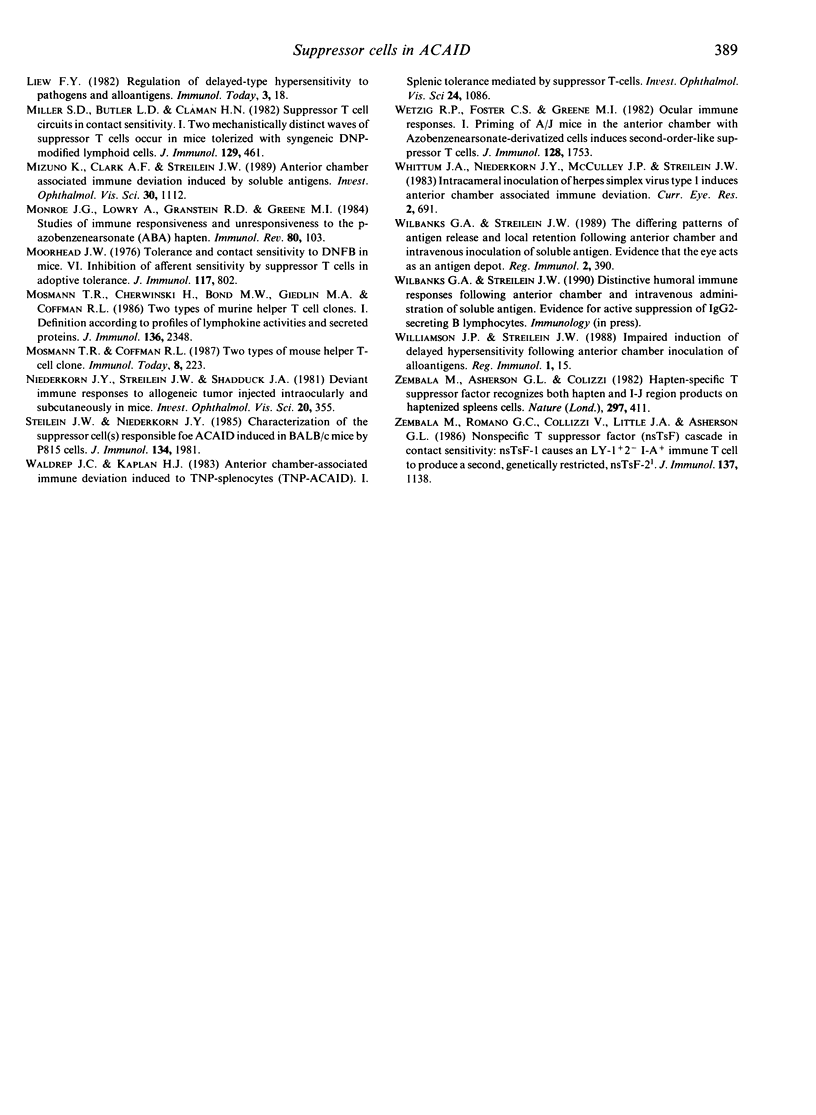
Selected References
These references are in PubMed. This may not be the complete list of references from this article.
- BECKER B. The measurement of rate of aqueous flow with iodide. Invest Ophthalmol. 1962 Feb;1:52–58. [PubMed] [Google Scholar]
- Benacerraf B., Germain R. N. A single major pathway of T-lymphocyte interactions in antigen-specific immune suppression. Scand J Immunol. 1981;13(1):1–10. doi: 10.1111/j.1365-3083.1981.tb00104.x. [DOI] [PubMed] [Google Scholar]
- Bill A. Blood circulation and fluid dynamics in the eye. Physiol Rev. 1975 Jul;55(3):383–417. doi: 10.1152/physrev.1975.55.3.383. [DOI] [PubMed] [Google Scholar]
- Ferguson T. A., Waldrep J. C., Kaplan H. J. The immune response and the eye. II. The nature of T suppressor cell induction in anterior chamber-associated immune deviation (ACAID). J Immunol. 1987 Jul 15;139(2):352–357. [PubMed] [Google Scholar]
- Heuer J., Brüner K., Opalka B., Kölsch E. A cloned T-cell line from a tolerant mouse represents a novel antigen-specific suppressor cell type. Nature. 1982 Apr 1;296(5856):456–459. doi: 10.1038/296456a0. [DOI] [PubMed] [Google Scholar]
- Horowitz J. B., Kaye J., Conrad P. J., Katz M. E., Janeway C. A., Jr Autocrine growth inhibition of a cloned line of helper T cells. Proc Natl Acad Sci U S A. 1986 Mar;83(6):1886–1890. doi: 10.1073/pnas.83.6.1886. [DOI] [PMC free article] [PubMed] [Google Scholar]
- Kaplan H. J., Streilein J. W., Stevens T. R. Transplantation immunology of the anterior chamber of the eye. II. Immune response to allogeneic cells. J Immunol. 1975 Sep;115(3):805–810. [PubMed] [Google Scholar]
- Miller S. D., Butler L. D., Claman H. N. Suppressor T cell circuits in contact sensitivity. I. Two mechanistically distinct waves of suppressor T cells occur in mice tolerized with syngeneic DNP-modified lymphoid cells. J Immunol. 1982 Aug;129(2):461–468. [PubMed] [Google Scholar]
- Mizuno K., Clark A. F., Streilein J. W. Anterior chamber-associated immune deviation induced by soluble antigens. Invest Ophthalmol Vis Sci. 1989 Jun;30(6):1112–1119. [PubMed] [Google Scholar]
- Monroe J. G., Lowy A., Granstein R. D., Greene M. I. Studies of immune responsiveness and unresponsiveness to the p-azobenzenearsonate (ABA) hapten. Immunol Rev. 1984 Aug;80:103–131. doi: 10.1111/j.1600-065x.1984.tb00497.x. [DOI] [PubMed] [Google Scholar]
- Moorhead J. W. Tolerance and contact sensitivity to DNFB in mice. VI. Inhibition of afferent sensitivity by suppressor T cells in adoptive tolerance. J Immunol. 1976 Sep;117(3):802–806. [PubMed] [Google Scholar]
- Mosmann T. R., Cherwinski H., Bond M. W., Giedlin M. A., Coffman R. L. Two types of murine helper T cell clone. I. Definition according to profiles of lymphokine activities and secreted proteins. J Immunol. 1986 Apr 1;136(7):2348–2357. [PubMed] [Google Scholar]
- Niederkorn J., Streilein J. W., Shadduck J. A. Deviant immune responses to allogeneic tumors injected intracamerally and subcutaneously in mice. Invest Ophthalmol Vis Sci. 1981 Mar;20(3):355–363. [PubMed] [Google Scholar]
- Waldrep J. C., Kaplan H. J. Anterior chamber associated immune deviation induced by TNP-splenocytes (TNP-ACAID). I. Systemic tolerance mediated by suppressor T-cells. Invest Ophthalmol Vis Sci. 1983 Aug;24(8):1086–1092. [PubMed] [Google Scholar]
- Wetzig R. P., Foster C. S., Greene M. I. Ocular immune responses. I. Priming of A/J mice in the anterior chamber with azobenzenearsonate-derivatized cells induces second-order-like suppressor T cells. J Immunol. 1982 Apr;128(4):1753–1757. [PubMed] [Google Scholar]
- Whittum J. A., Niederkorn J. Y., McCulley J. P., Streilein J. W. Intracameral inoculation of herpes simplex virus type I induces anterior chamber associated immune deviation. Curr Eye Res. 1982;2(10):691–697. doi: 10.3109/02713688209019998. [DOI] [PubMed] [Google Scholar]
- Wilbanks G. A., Streilein J. W. The differing patterns of antigen release and local retention following anterior chamber and intravenous inoculation of soluble antigen. Evidence that the eye acts as an antigen depot. Reg Immunol. 1989 Nov-Dec;2(6):390–398. [PubMed] [Google Scholar]
- Williamson J. S., Streilein J. W. Impaired induction of delayed hypersensitivity following anterior chamber inoculation of alloantigens. Reg Immunol. 1988 Jul-Aug;1(1):15–23. [PubMed] [Google Scholar]
- Zembala M., Asherson G. L., Colizzi V. Hapten-specific T suppressor factor recognizes both hapten and I-J region products on haptenized spleen cells. Nature. 1982 Jun 3;297(5865):411–413. doi: 10.1038/297411a0. [DOI] [PubMed] [Google Scholar]
- Zembala M., Romano G. C., Colizzi V., Little J. A., Asherson G. L. Nonspecific T suppressor factor (nsTsF) cascade in contact sensitivity: nsTsF-1 causes an Ly-1+2- I-A+ immune T cell to produce a second, genetically restricted, nsTsF-2. J Immunol. 1986 Aug 15;137(4):1138–1143. [PubMed] [Google Scholar]


